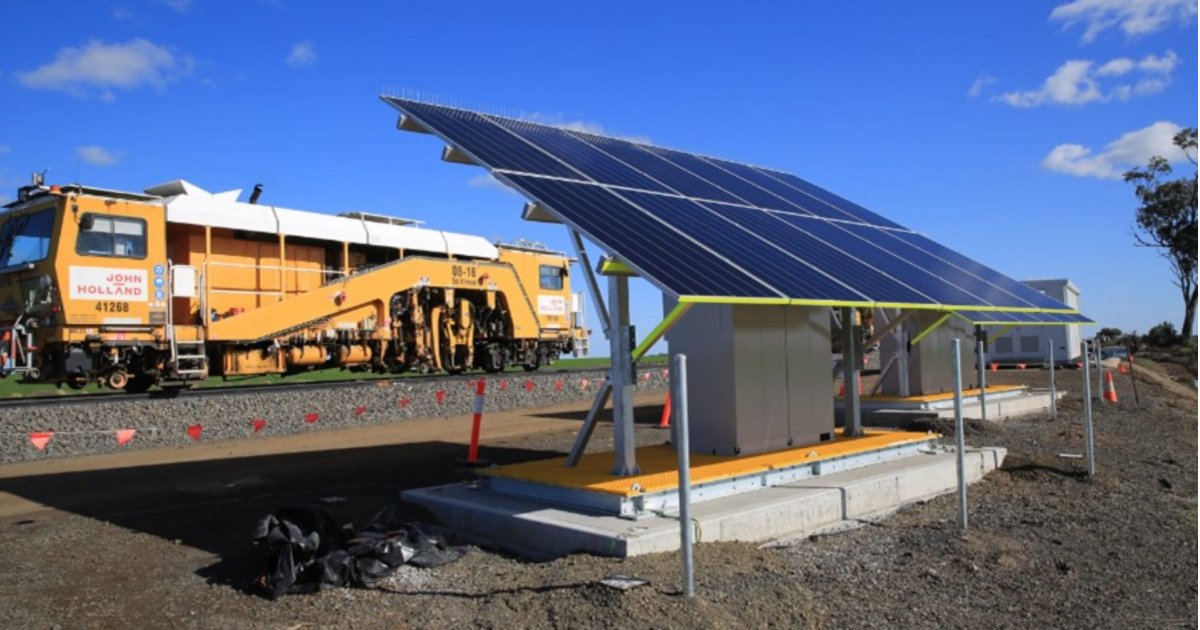
Australia’s largest freight rail infrastructure project is using solar panels and batteries to power signalling operations on part of the network.
Inland Rail is a 1,700 kilometre freight rail line project directly connecting Melbourne and Brisbane via regional Victoria, New South Wales and Queensland. The project is being delivered by the Australian Government through the Australian Rail Track Corporation (ARTC), in partnership with the private sector. Construction commenced in 2018 and it’s anticipated this will be completed in 2027.
Comprised of 13 individual projects across 36 local government areas, Inland Rail will provide a consistent standard gauge connection from Melbourne to Brisbane; as well as a dual gauge connection in Queensland. 1,100 kilometres of existing rail line is being upgraded and 600 kilometres of new track built to connect missing links between Melbourne and Brisbane.
Currently, 74% of all inter-capital freight between Melbourne and Brisbane is transported via road. According to the ARTC web site, moving freight by rail is four times more fuel-efficient. ARTC says Inland Rail will reduce road congestion and cut carbon emissions by 750,000 tonnes per year from 2050.
Why was 2050 chosen instead of a year closer to completion date? I have no idea. By 2050, electric vehicles (including trucks) will be ubiquitous – but less road congestion is certainly a good thing.
Another emissions reduction opportunity is through the use of solar power for functions such as line signalling. ARTC announced yesterday its first solar installation on the network at Coolleearlee in New South Wales; around 50 kilometres from Moree. The system will be powering signalling on the Narromine to North Star (N2NS) section of the network.
Big Savings Using Solar Energy
Aside from emissions reduction and electricity cost savings, using solar power backed by battery storage (10 days backup) is saving ARTC $300,000 in costs. This is mostly from avoiding having to dig 2.2 kilometres of new trenching to connect to the mains grid.
“Delivering power to rural signalling systems can be a real challenge so the successful completion of this solar powered system in Coolleearlee is a great outcome,” said Peter Borrelli, Project Director for N2NS at Inland Rail. “We always seek to minimise disruption to local communities so using solar rather than mains power with all the construction work that would involve is a great result for the local community too.”
ARTC estimates the new solar system will “save nearly 7 million tonnes of carbon emissions annually” and more than $10,000 per year in operational electricity costs. The capacity of the system isn’t mentioned and there may be more panel arrays than shown above. But given the general nature of the system and electricity cost savings indicated, it won’t be avoiding 7 million tonnes of CO2e a year. Not even close. Double-digit tonnes annually (and low double-digits) are likely much, much closer to the mark.
Still, it’s a great use of solar power. And while on the issue of emissions, perhaps in the not-too-distant future we’ll also see electric locomotives using the network.
You can learn more about the Inland Rail project here.

 RSS - Posts
RSS - Posts



Speak Your Mind